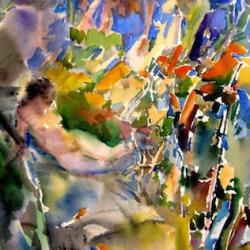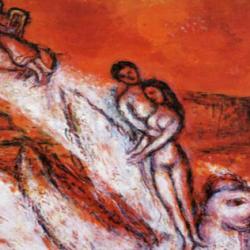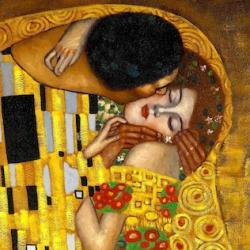The first phrase of Song of Songs 1:5 is usually taken as a contrast – “black but lovely,” though some have noted that this is not a necessary translation of the phrase. It seems the most likely, though, that the blackness is seen as a negative, but in spite of her blackness, she remains beautiful. Verse 6 confirms that there is something negative about her coloring – she is blackish, swarthy (in Hebrew a form of the same word) because she has been forced to work outside, and has been “gazed upon” by the hot sun, and she expects the daughters of Jerusalem to despise her because of her coloring. She has suffered some punishment and the color of her skin is a sign of that suffering.
Though there is a contrast here, there also seems to be a connection. Her blackness has somehow become a mark of her beauty. What does that imply?
Apparently, the “daughters of Jerusalem” that the bride addresses don’t have the same dark complexion, or else the Bride would not be concerned about the possibility that they might show contempt for her. So we have two sorts of women here, the daughters of Jerusalem, who are associated by their title and their complexion with the city, and the Bride who is dark, black, and who is associated not with the city but the land. She is the color of earth, and she says that she was forced to work in the open sun in the vineyards. She represents a natural world, a cultivated natural world, but a natural world, perhaps a garden world, in contrast to the world of the daughters, which is an urban, civic world. The contrast between the Bride and the daughters is a contrast between natural and cultural, between garden and city.
We arrive at a similar conclusion by glancing at the other uses of “comely” or “beautiful” in the Song. The word is used to describe the bride’s face (2:14), but also to describe her speech, which is fitting (4:3; cf. Proverbs 17:7). The most interesting use is in 6:4, where the beauty of the bride is compared to the beauty of the city of Jerusalem, and said to be as “terrible as an army of banners.” This is part of the glorification of the bride. The Lover conquers his beloved at the beginning of the Song (his “banner” is over her, 2:4), but by the end the lover is himself conquered by the bride. Her black beauty is captivating, controlling, overwhelming.
The similes in 1:5 confirm this. She is black but beautiful, like the tents of Kedar. What do we know about Kedar? On the surface of things, there is a double connection with blackness. Kedar’s tents would be black. Kedar also means “to blacken,” and so the connection is multiple. But the comparison with the tents of Kedar brings up another set of reinforcing associations. Kedar is a son of Ishmael (Gen 25:13; 1 Chronicles 1:29). Ishmael is the firstborn of Abraham, but the rejected firstborn, the firstborn who is moved out to make room for Isaac the second born son. He is the proto-Israel, who is blessed, bears 12 sons who become princes (Genesis 17:20-21). The angel in the wilderness tells Hagar that her son will be a “wild donkey of a man” whose “hand will be against everyone, and everyone’s hand will be against him.” Ishmael is a man of the east (Genesis 16:11-12). Her beauty is like the beauty of the tents of Ishmael, and that carries these various associations.
Kedar is also linked to Arabia in various places. The closest is in Ezekiel’s prophecy against Tyre. Tyre is going to lose all her trading partners, among them “Arabia and all the princes of Kedar” (27:21). The nomadic herdsmen and sheiks of Arabia and Kedar bring their animals to Tyre to trade. Kedar is also mentioned twice in Isaiah 21 (vv. 167-17), in an oracle concerning Arabia, and in Isaiah 42:11 they are dwellers in the wilderness. For the Psalmist, Kedar is a place of exile and distance from God (Psalm 120:5), but Isaiah envisions a time when the flocks of Kedar will be brought not to Tyre but to Zion, when the animals that are raised in the wilderness will become ministers on Yahweh’s altar (60:7). Again, there is a note of exoticism, “Orientalism,” in the description of the precious riches of the east that will come with the flocks of Kedar into Jerusalem, as part of the pilgrimage of the nations to Yahweh’s house. Even the most exotic and distant peoples and their treasures will be brought into the renewed Jerusalem.
Kedar’s “tents” thus evoke something wild and untamed, a beauty that is exotic and alien, a beauty associated not with the lush fullness of the garden but with the harsh clarity of the desert, a beauty that is other . It’s a beauty associated not with the stable and settled life of the city, the daughters of Jerusalem, but with the transient nomadic life of the Arab Bedouins. Yet, the very strangeness of her beauty is part of the bride’s fascination for her lover.
She also compares her beauty to the curtains of Solomon. The word for curtains is used almost exclusively with reference to the curtains that made up the tabernacle (Exodus 26:1-13; 36:8-17; Numbers 4:25) or the curtains of David’s ark-tabernacle (2 Samuel 7:2; 1 Chronicles 17:1). One Psalm compares the heavens to a curtain that the Lord stretches out (Psalm 104:2). The curtains of the tabernacle are like an architectural firmament, analogous to the curtain of the sky that covers the world. The word here is never used in the temple descriptions, but it is used twice in Jeremiah in contexts that appear to refer to the Lord’s laments over His curtains (4:20; 10:20). The word is used once, tantalizingly, in connection with Nebuchadnezzar’s defeat of the nomads of Kedar (Jeremiah 49:28-29); the king of Babylon carries away Kedar’s tents, flocks, and tent curtains. I think the Song is referring to the curtains of Solomon’s temple, not the curtains of His palace. Her beauty is like the beauty of the intricately designed curtains of the temple?
This seems to move in the opposite direction from the first simile. The first emphasizes the strangeness and wildness of her beauty, but the second simile links her beauty with high art, artifice. How is she like the curtains of Solomon? The two similes do go in opposite directions, polar opposites in a sense. East is the direction of removal from God’s presence; the wilderness is at the opposite pole from the garden-temple. These are the furthest symbolic poles of biblical topography: Far east v. center of the world. The tents of Kedar are dwellings that are as “outside” as you can get – outside fixed homes, outside city walls, outside the cultivated land, all the way into the howling wilderness; the tents of Solomon are as “inside” as you can get – in the city, in the citadel of the city, in the central building of the citadel, in the inner chambers of the temple. Kedar is far from God; the curtains of Solomon are near.
But the two poles share certain characteristics. Both, after all, are forbidden, inaccessible, dangerous. The wilderness is dangerous and forbidding for obvious reasons, but the temple is equally forbidding. No one can go in to see the curtain of Solomon because it is in the house of Yahweh. That beauty is also a terrifying, overwhelming beauty, a beauty linked with fear, the beauty of the other. We might draw some conclusions about the beauty of Yahweh from this: Whatever we might say about Yahweh’s glory, it is not a domesticated beauty. The beauty of Solomon’s curtains in the Lord’s house are beauties that can fittingly be brought into conjunction with the beauties of the wilderness and Kedar. Yahweh’s is not Apollonian beauty; Dionysian more like. Or, if the surface is Apollonian (there are, after all, pillars and porches and
passages in Solomon’s temple), there is a Dionysian energy ready to burst out from beneath.











